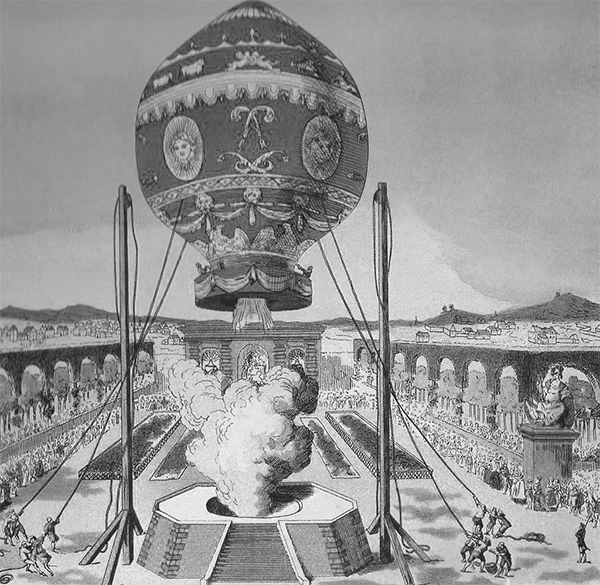First hot air balloon flight
1783In 1783, two brothers demonstrated their invention, the hot air balloon, before a crowd of dignitaries in Annonay, France.
Joseph-Michel and Jacques-Étienne Montgolfier, prosperous paper manufacturers (a high-tech industry at the time), experimented with lighter-than-air devices after observing that heated air directed into a paper or fabric bag made the bag rise. After several successful tests, the brothers decided to publicly demonstrate their invention.
The Montgolfiers built a balloon made of silk and lined with paper that was 33 feet (10 meters) in diameter and launched it — with nobody aboard — from the marketplace in Annonay on June 4, 1783, according to Encyclopedia Britannica. The balloon rose to between 5,200 and 6,600 feet (1,600 to 2,000 m) and stayed aloft for 10 minutes, traveling more than a mile (about 2 kilometers).
Word of the brothers' success quickly spread, and a demonstration for the king of France was planned. For this flight, the brothers enlisted the help of Jean-Baptiste Réveillon, a successful wallpaper manufacturer, according to the Palace of Versailles museum. The inventors constructed a balloon about 30 feet (9 m) in diameter made of taffeta and coated with a varnish of alum for fireproofing. Réveillion's influence was apparent, as the balloon was decorated with golden flourishes, zodiac signs and suns, together symbolizing the French monarch of the time, King Louis XVI.
There was some concern about the effects of high altitude on humans. The king proposed a test using prisoners, but the Montgolfiers instead suspended a basket below the balloon containing a sheep, a duck and a rooster, according to Time magazine. The idea was scientifically sound: The sheep's physiology was thought to be similar to a human's; the high-flying duck was unlikely to be harmed, so it was used as a control. And the rooster was included as a further control because, while it was also a bird, it did not fly at high altitudes.
There was some concern about the effects of high altitude on humans. The king proposed a test using prisoners, but the Montgolfiers instead suspended a basket below the balloon containing a sheep, a duck and a rooster, according to Time magazine. The idea was scientifically sound: The sheep's physiology was thought to be similar to a human's; the high-flying duck was unlikely to be harmed, so it was used as a control. And the rooster was included as a further control because, while it was also a bird, it did not fly at high altitudes.
There was some concern about the effects of high altitude on humans. The king proposed a test using prisoners, but the Montgolfiers instead suspended a basket below the balloon containing a sheep, a duck and a rooster, according to Time magazine. The idea was scientifically sound: The sheep's physiology was thought to be similar to a human's; the high-flying duck was unlikely to be harmed, so it was used as a control. And the rooster was included as a further control because, while it was also a bird, it did not fly at high altitudes.



